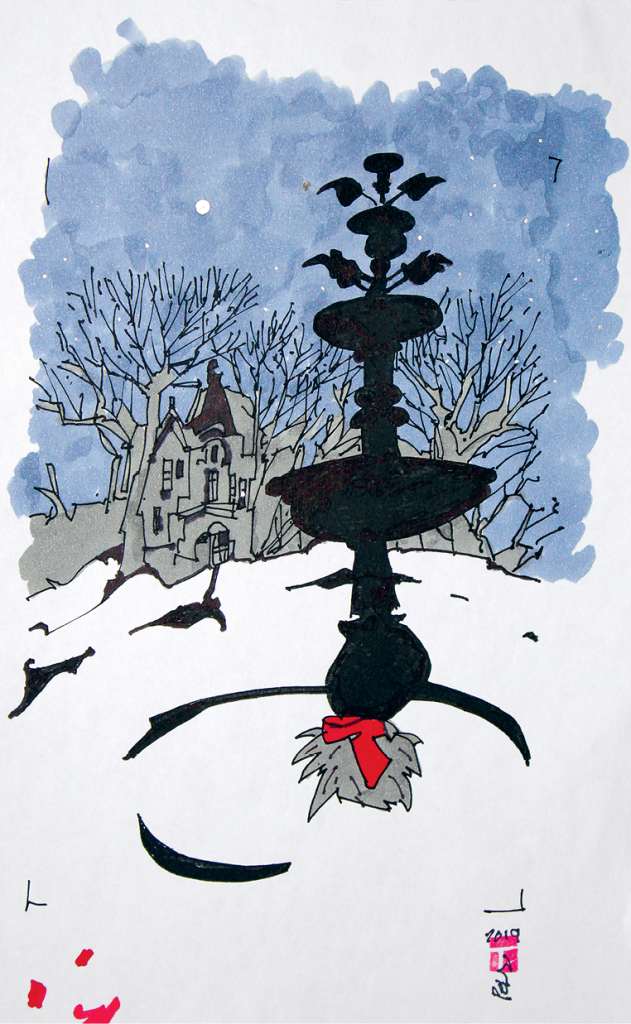My family once lived in Irvine Park, a community that was developed in the mid-nineteenth century by some of Saint Paul’s most influential families. It was an era of horse-drawn carriages, magnificent houses, and elegant parties where champagne flowed in marble fountains.
After the turn of the century, the wealth declined and so did the houses. Roofs sagged. Bricks crumbled. Walls leaned.
By the time we moved to Irvine Park in the 1950s, the once splendid homes were owned by absentee landlords and subdivided into minimal living units.
Our first apartment had only one bedroom for a family of five. It was here that my oldest brother and I indulged a curiosity about the effect fire had on varying substances. We wondered what would happen to gum wrappers, scraps of shingles, hair, bits of torn cloth, and newspaper when exposed to flame. We snuck matches from our cigarette-smoking parents and performed our experiments in the basement of our apartment building. One day the landlord interrogated everyone who lived in the building, asking if anyone had seen his wife. She had left him, and he suspected she was living in the basement because there were tell-tale signs. He’d found fire residue on the basement’s cement floor.
The fear of discovery prompted my brother and I to give up our delinquent behavior.
When my youngest brother was born, increasing our family size to six, we moved down the street to a two-bedroom apartment. It was not uncommon for families nearly as large as ours to live in two-room apartments. Despite our limited space, we were luckier than some of our neighbors.
My parents struggled to manage with less-than-reliable living arrangements—inadequate appliances and plumbing. Off-site landlords were slow to repair broken window sashes and water leaks.
But life was good for my oldest brother and me. We lived by the street lights rule. When they were turned on in the early evening, it was time for us to get home. We roamed with a small gang of kids around our age. We played marbles on the broken sidewalks, slid down the hill inside the park using cardboard in all seasons, and climbed the limestone cliffs adjacent to the river. That last one had to be kept secret from our parents. They would have grounded us for life.
In winter, when the snow on the hill became hard-packed from our incessant sliding down it, we swapped our cardboard sleds for ice skates and skated down the hill, challenging one another to reach the greatest distance.
In 1959 we moved on to another neighborhood ahead of an eviction notice. Subsequently, the Irvine Park neighborhood underwent a transformation to its former glory. Well, almost. I don’t believe there are any marble fountains bubbling forth champagne.
When I tell people that I once lived in Irvine Park, a look of awe comes upon them. Usually I explain that when I lived there, the park was in decline. But sometimes I don’t.

Irvine Park
In 1829, landowner John Irvine, who was interested in preserving green space in the growing community, gave a plot of land to the Village of Saint Paul. It was part of a larger tract where livestock grazed and women hung their laundry out to dry in the breezes that rose from the river basin.
Once developed, the park attracted affluent, influential families, who built magnificent houses there. Still standing today is the Ohage House, built by Dr. Justus Ohage, who established Saint Paul’s public health department and was famous for performing the first successful gall bladder operation in the United States. And the Murray-Lanpher House, the grand Queen Anne situated on the corner of Irvine Park and Ryan Avenue, built by Michael Murray, founder of Northern Cooperage Co., a barrel manufacturer.
After the turn of the century, the wealth of the neighborhood began to decline. By 1970, 96 percent of the homes were classified as substandard by the city. Demolition of the area was planned.
However, neighbors recognized the historical significance of the area and fought to save the Park and the remaining houses (some had already been lost to decay). They joined forces with the city’s Housing and Redevelopment Authority, the Minnesota Historical Society, and the Ramsey County Historical Society. The area was saved, making restoration possible, when it was listed on the National Register of Historic Places.
A gazebo and fountain were installed in the Park and the remaining homes were restored to their original grandeur. Houses from within the neighborhood and elsewhere were moved into the Park to fill the empty spaces created by houses that didn’t survive.
Today Irving Park is a quiet residential neighborhood, and one of Saint Paul’s most popular outdoor wedding ceremony locations.
Art By: